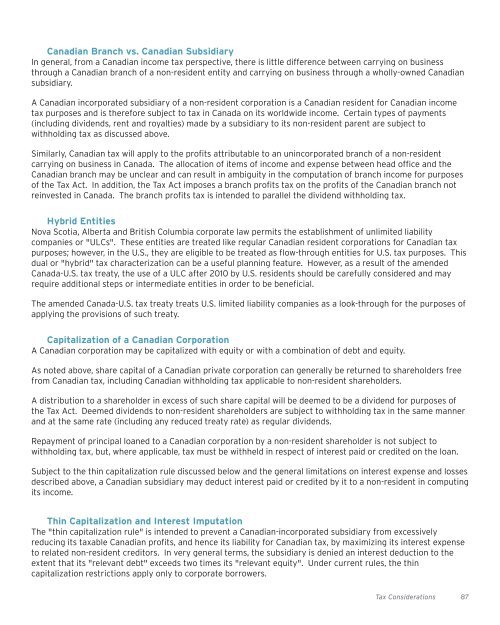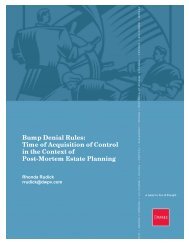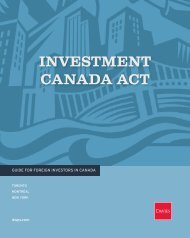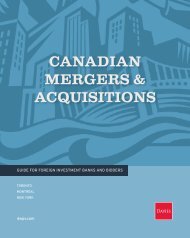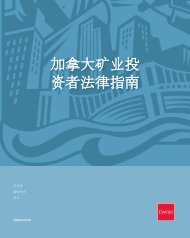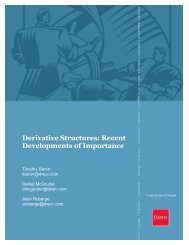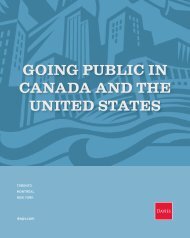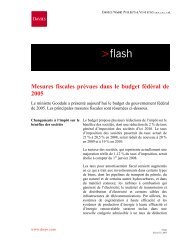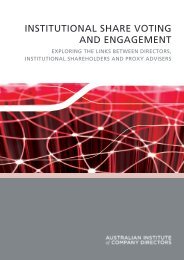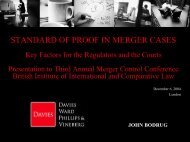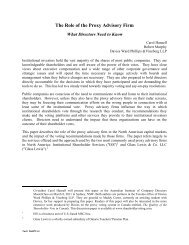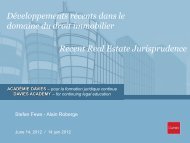Canadian Branch vs. Canadian SubsidiaryIn general, from a Canadian <strong>in</strong>come tax perspective, there is little difference between carry<strong>in</strong>g on <strong>bus<strong>in</strong>ess</strong>through a Canadian branch of a non-resident entity and carry<strong>in</strong>g on <strong>bus<strong>in</strong>ess</strong> through a wholly-owned Canadiansubsidiary.A Canadian <strong>in</strong>corporated subsidiary of a non-resident corporation is a Canadian resident for Canadian <strong>in</strong>cometax purposes and is therefore subject to tax <strong>in</strong> Canada on its worldwide <strong>in</strong>come. Certa<strong>in</strong> types of payments(<strong>in</strong>clud<strong>in</strong>g dividends, rent and royalties) made by a subsidiary to its non-resident parent are subject towithhold<strong>in</strong>g tax as discussed above.Similarly, Canadian tax will apply to the profits attributable to an un<strong>in</strong>corporated branch of a non-residentcarry<strong>in</strong>g on <strong>bus<strong>in</strong>ess</strong> <strong>in</strong> Canada. The allocation of items of <strong>in</strong>come and expense between head office and theCanadian branch may be unclear and can result <strong>in</strong> ambiguity <strong>in</strong> the computation of branch <strong>in</strong>come for purposesof the Tax Act. In addition, the Tax Act imposes a branch profits tax on the profits of the Canadian branch notre<strong>in</strong>vested <strong>in</strong> Canada. The branch profits tax is <strong>in</strong>tended to parallel the dividend withhold<strong>in</strong>g tax.Hybrid EntitiesNova Scotia, Alberta and British Columbia corporate law permits the establishment of unlimited liabilitycompanies or "ULCs". These entities are treated like regular Canadian resident corporations for Canadian taxpurposes; however, <strong>in</strong> the U.S., they are eligible to be treated as flow-through entities for U.S. tax purposes. Thisdual or "hybrid" tax characterization can be a useful plann<strong>in</strong>g feature. However, as a result of the amendedCanada-U.S. tax treaty, the use of a ULC after 2010 by U.S. residents should be carefully considered and mayrequire additional steps or <strong>in</strong>termediate entities <strong>in</strong> order to be beneficial.The amended Canada-U.S. tax treaty treats U.S. limited liability companies as a look-through for the purposes ofapply<strong>in</strong>g the provisions of such treaty.Capitalization of a Canadian CorporationA Canadian corporation may be capitalized with equity or with a comb<strong>in</strong>ation of debt and equity.As noted above, share capital of a Canadian private corporation can generally be returned to shareholders freefrom Canadian tax, <strong>in</strong>clud<strong>in</strong>g Canadian withhold<strong>in</strong>g tax applicable to non-resident shareholders.A distribution to a shareholder <strong>in</strong> excess of such share capital will be deemed to be a dividend for purposes ofthe Tax Act. Deemed dividends to non-resident shareholders are subject to withhold<strong>in</strong>g tax <strong>in</strong> the same mannerand at the same rate (<strong>in</strong>clud<strong>in</strong>g any reduced treaty rate) as regular dividends.Repayment of pr<strong>in</strong>cipal loaned to a Canadian corporation by a non-resident shareholder is not subject towithhold<strong>in</strong>g tax, but, where applicable, tax must be withheld <strong>in</strong> respect of <strong>in</strong>terest paid or credited on the loan.Subject to the th<strong>in</strong> capitalization rule discussed below and the general limitations on <strong>in</strong>terest expense and lossesdescribed above, a Canadian subsidiary may deduct <strong>in</strong>terest paid or credited by it to a non-resident <strong>in</strong> comput<strong>in</strong>gits <strong>in</strong>come.Th<strong>in</strong> Capitalization and Interest ImputationThe "th<strong>in</strong> capitalization rule" is <strong>in</strong>tended to prevent a Canadian-<strong>in</strong>corporated subsidiary from excessivelyreduc<strong>in</strong>g its taxable Canadian profits, and hence its liability for Canadian tax, by maximiz<strong>in</strong>g its <strong>in</strong>terest expenseto related non-resident creditors. In very general terms, the subsidiary is denied an <strong>in</strong>terest deduction to theextent that its "relevant debt" exceeds two times its "relevant equity". Under current rules, the th<strong>in</strong>capitalization restrictions apply only to corporate borrowers.Tax Considerations 87
Conversely, where a Canadian resident corporation has made a loan to a non-resident and it is outstand<strong>in</strong>g forone year or more and the loan does not bear a reasonable rate of <strong>in</strong>terest, <strong>in</strong>terest <strong>in</strong>come calculated at aprescribed rate on the pr<strong>in</strong>cipal amount outstand<strong>in</strong>g is imputed by the Tax Act to the Canadian lender.TRANSFER PRICING RULESCanada, like many other countries, employs transfer pric<strong>in</strong>g rules to protect its tax base. The rules are designedto ensure that the <strong>in</strong>come of Canadian taxpayers (and their correspond<strong>in</strong>g Canadian tax liability) is notartificially reduced through non-arm's length transactions with related non-residents.The transfer pric<strong>in</strong>g rules apply to Canadian residents and to non-residents carry<strong>in</strong>g on <strong>bus<strong>in</strong>ess</strong> <strong>in</strong> Canada;therefore, these rules are potentially relevant to both Canadian subsidiaries (and parent companies) andCanadian branches. The pric<strong>in</strong>g of goods and the quantum of management fees, guarantee fees and royaltiesare common matters for transfer pric<strong>in</strong>g scrut<strong>in</strong>y.Where a Canadian taxpayer or a partnership participates <strong>in</strong> one or more transactions with a non-arm's lengthnon-resident and either (i) the terms of the transactions differ from those that would have been made by arm'slength persons or (ii) the transactions are not bona fide transactions entered <strong>in</strong>to for non-tax purposes andwould not have been entered <strong>in</strong>to by arm's length persons, then CRA can make adjustments pursuant to thetransfer pric<strong>in</strong>g rules <strong>in</strong> the Tax Act, <strong>in</strong>clud<strong>in</strong>g imput<strong>in</strong>g <strong>in</strong>come or deny<strong>in</strong>g deductions.In addition, penalties can be levied. Where a taxpayer's transfer pric<strong>in</strong>g adjustments for a year exceed the lesserof $5 million and the taxpayer's gross revenue for the year computed <strong>in</strong> accordance with the Tax Act, a penaltyequal to 10% of the total transfer pric<strong>in</strong>g adjustments applies unless reasonable efforts were made to applyarm's length terms. For these purposes, a taxpayer will be deemed not to have made reasonable efforts to applyarm's length terms unless the taxpayer makes or obta<strong>in</strong>s complete records of the transactions establish<strong>in</strong>g theappropriateness of the transactions from a transfer pric<strong>in</strong>g perspective no later than the taxpayer's tax returndue date (or <strong>in</strong> the case of a partnership, its annual <strong>in</strong>formation return due date). This rule is often referred toas the contemporaneous documentation requirement.CRA has special audit powers <strong>in</strong> transfer pric<strong>in</strong>g matters and can require that a taxpayer producecontemporaneous documentation with<strong>in</strong> 90 days of CRA mak<strong>in</strong>g a formal request. In recent years, CRA hasbecome more aggressive <strong>in</strong> its audit<strong>in</strong>g of transfer pric<strong>in</strong>g records.TAX INCENTIVES AND SPECIAL REGIMESThe federal government and many prov<strong>in</strong>cial governments provide tax <strong>in</strong>centives for certa<strong>in</strong> <strong>bus<strong>in</strong>ess</strong> activities<strong>in</strong> the form of tax credits, reduced tax rates and accelerated write-offs of qualify<strong>in</strong>g expenditures. In addition,special tax regimes may apply to certa<strong>in</strong> undertak<strong>in</strong>gs, notably, as discussed above, the exploration anddevelopment of resource properties. The applicable rules and eligibility criteria are complex and beyond thescope of this summary; however, some of the more common tax <strong>in</strong>centives available federally and <strong>in</strong> Ontario andQuébec are noted below. In addition, the Tax Act provides reduced tax rates and certa<strong>in</strong> other benefits tocorporations that meet the def<strong>in</strong>ition of "Canadian-controlled private corporation" or "CCPC", essentially aprivate Canadian corporation that is not controlled directly or <strong>in</strong>directly <strong>in</strong> any way by one or more publiccorporations or non-residents or any comb<strong>in</strong>ation of them.Scientific Research and Experimental Development IncentivesThe Tax Act conta<strong>in</strong>s generous <strong>in</strong>centives for "scientific research and experimental development" ("SR&ED").SR&ED means systematic <strong>in</strong>vestigation or search carried out <strong>in</strong> a field of science or technology that is basic orapplied research or experimental development, <strong>in</strong>clud<strong>in</strong>g work with respect to eng<strong>in</strong>eer<strong>in</strong>g, design, operationsresearch, mathematical analysis and test<strong>in</strong>g. Some activities are explicitly excluded from SR&ED, <strong>in</strong>clud<strong>in</strong>gmarket<strong>in</strong>g, quality control, social science research, m<strong>in</strong>eral or oil and gas exploration or production, commercialproduction and rout<strong>in</strong>e data collection.88 Tax Considerations
- Page 1 and 2:
DOING BUSINESSIN CANADAYOUR COMPLET
- Page 3 and 4:
ONTENTSTABLE OF CONTENTSINTRODUCTIO
- Page 5 and 6:
IntroductionPOLITICAL AND CONSTITUT
- Page 7 and 8:
5RealEstateIndustrial and Intellect
- Page 9 and 10:
accordance with directions from the
- Page 11 and 12:
TITLE INSURANCE, TITLE OPINIONS AND
- Page 13 and 14:
11EnvironmentalLawIndustrial and In
- Page 15 and 16:
commercial activities, or carrying
- Page 17 and 18:
The federal government currently re
- Page 19 and 20:
17Types ofBusiness OrganizationIndu
- Page 21 and 22:
provincial law cannot do so as of r
- Page 23 and 24:
partnership, limited partners’ li
- Page 25 and 26:
parties. In Québec, joint venturer
- Page 27 and 28:
25Financing aBusiness OperationIndu
- Page 29 and 30:
The Civil Code of Québec provides
- Page 31 and 32:
29CorporateGovernanceIndustrial and
- Page 33 and 34:
Instrument 58-101. The practices re
- Page 35 and 36: 33CompetitionLawIndustrial and Inte
- Page 37 and 38: BID-RIGGINGBid rigging is any agree
- Page 39 and 40: anticompetitive agreements among co
- Page 41 and 42: 39ForeignInvestmentIndustrial and I
- Page 43 and 44: apply for Canadian citizenship. (Pe
- Page 45 and 46: (D)GENERAL REVIEW THRESHOLDSThe fol
- Page 47 and 48: there be an "acquisition of control
- Page 49 and 50: Industrial and Intellectual Propert
- Page 51 and 52: to perform or cause them to be perf
- Page 53 and 54: Registration grants an exclusive ri
- Page 55 and 56: PIPEDA applies in all provinces of
- Page 57 and 58: Employment LawCanadian employment l
- Page 59 and 60: displacement, laying-off, suspensio
- Page 61 and 62: easonable cause to believe that the
- Page 63 and 64: 63Retirement Plans, EmployeeBenefit
- Page 65 and 66: • funding;• eligibility;• pen
- Page 67 and 68: 67Temporary Entry andPermanent Resi
- Page 69 and 70: INTERNATIONAL AGREEMENTSIn recent y
- Page 71 and 72: immigrant in another class, he or s
- Page 73 and 74: 73Bankruptcy andInsolvency Proceedi
- Page 75 and 76: BANKRUPTCYBankruptcy results in the
- Page 77 and 78: INTERNATIONAL BANKRUPTCYASSETS LOCA
- Page 79 and 80: Tax ConsiderationsThis chapter prov
- Page 81 and 82: TAX REPORTINGAnnual Tax ReturnsCana
- Page 83 and 84: Québec has legislation that limits
- Page 85: Amendments, SIFTs and their unithol
- Page 89 and 90: A person, whether resident in Canad
- Page 91 and 92: APPENDIX I: CANADA’S IN FORCE TAX
- Page 93: TORONTODAVIES WARD PHILLIPS & VINEB


